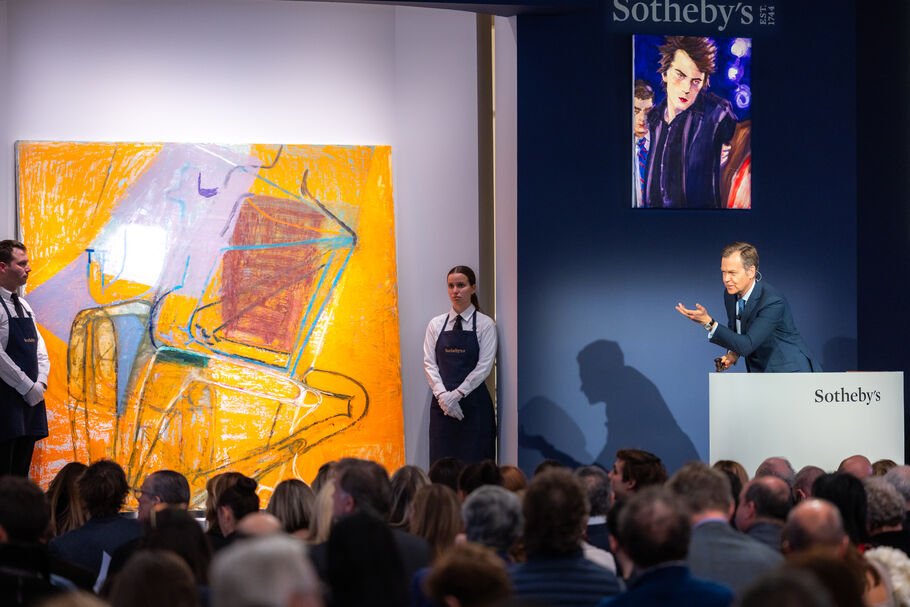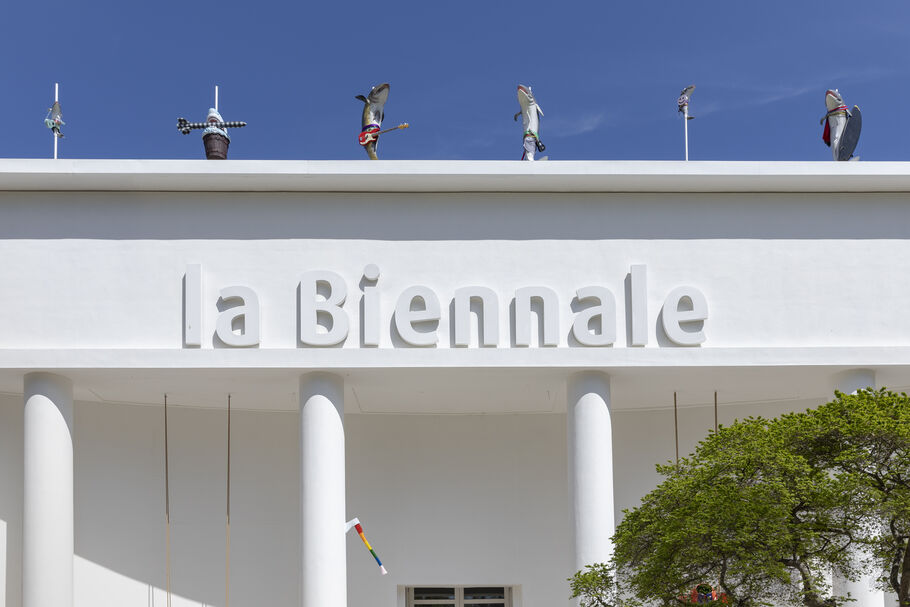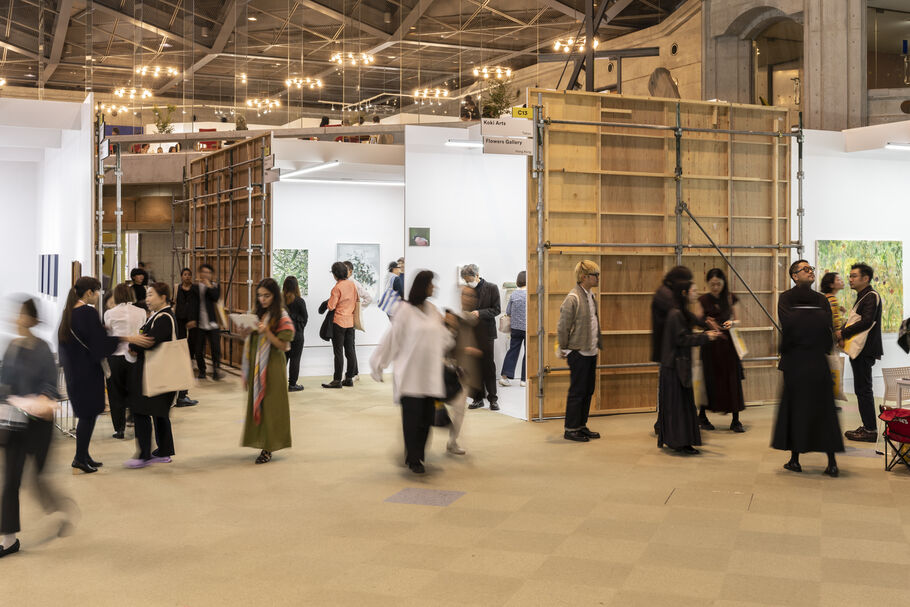Source: Artsy.
Following a tricky year for the art market, 2024 begins on note of anticipation. While economic growth is forecast to slow and geopolitical tensions show no signs of abating, positive signals are surfacing—from falling inflation to the prospect of lower interest rates—and could inject the art market with a dose of much-needed confidence. Here, we share the five key themes to keep an eye on in the art market in 2024.
1. The performance of blue-chip works at auction

Contemporary Art Evening auction at Sotheby’s New York, November 2023. Courtesy of Sotheby’s.
It’s important to note that 2023 came after a bumper year of historical, record-breaking sales at auction, which partly explains the fall in numbers.
But that’s only part of the story. Another notable factor across auction sales last year was that several prominent blue-chip artists’ works—normally surefire bets under the hammer—failed to reach the low end of their presale estimates. Across New York’s blockbuster fortnight of auctions in November, for instance, works by George Condo, Alberto Giacometti, Keith Haring, Jeff Koons, Andy Warhol, Mark Bradford, and Salvador Dalí all hammered below their low targets. Auction houses also took steps to manage their sales by withdrawing some key lots—a worrying sign that demand wasn’t quite as strong as expected.
While blue-chip artworks are only a slice of the auction market, they are significant gauges of demand at the top end of the market. It will be interesting to see how and if they bounce back in 2024.
2. How positive economic forecasts could boost the art market
But 2024 carries several notes of concern. According to the International Monetary Fund (IMF), global economic growth is forecast to slow in 2024 to 2.9%, and the broader macroeconomic situation will remain highly volatile with conflicts, geopolitical tensions, and climate emergencies a persistent presence.
Like any global industry, the art market is susceptible to these tremors.
The good news for the economy, however, is that inflation appears to be turning a corner. The IMF tips global inflation to fall to 5.2% in 2024, compared to 6.8% in 2023 and 8.7% in 2022. In the U.S., it has fallen to as low as 3.1% (the rate from this past November). While many economists have cautioned that there is still a way to go, the signs are broadly positive. This applies to the art market, where galleries have had to shoulder a huge rise in operating costs in recent years: In Artsy’s Art Industry Trends report published last April, gallery professionals and dealers cited inflation as the most influential factor in setting artwork prices. With inflation set to slow into 2024, we can expect these price rises to soften.
It’s a similarly positive story with interest rates. Post-pandemic hikes in interest rates from central banks around the world have been broadly successful in taming inflation, and now it remains a question of when and not if rates will begin to fall. This is particularly important given the slowing growth figures mooted for the year ahead, and many economists are predicting as many as six rate cuts by the end of the year.
Low interest rates have historically been good news for the art market. The sustained period of low interest rates that followed the 2008 financial crisis led to exponential growth in the art market throughout the 2010s. It was cheaper than ever to borrow money, and a range of financialization tools made it easier to invest in art as an asset class. While interest rates are unlikely to fall to the lows of that period in 2024, it will undoubtedly be easier for buyers to borrow and transact on art purchases than it has been over the past year.
3. The artists poised for a breakout moment

Exterior view of the 59th International Art Exhibition – La Biennale di Venezia, 2022. Photo by Roberto Marossi. Courtesy of La Biennale di Venezia.
While the Venice Biennale is not officially a commercial event, there are plenty of galleries involved in the exhibitions throughout the Giardini and Arsenale, as well as in many pop-up shows and events around the city, and a strong collector presence. As such, the most buzzed-about artists of the Biennale often become the art market’s next darlings.
For instance, the Biennale’s main exhibition in 2022, “The Milk of Dreams,” took its name from a book of the same title by the late Surrealist artist Leonora Carrington, whose work was featured prominently in the Giardini. Less than a month after the opening of the Biennale, the artist’s auction record was broken and her work appeared four times in the top 10 sales at auction in 2022 by late women Surrealist artists.
As well as presenting names that are ripe for rediscovery, the Biennale is also sure to introduce new names and trending themes to a highly discerning and influential audience.
The Biennale is also known to amplify themes that are already gaining prominence in the art world. Take for example the U.S. pavilion, which will feature Jeffrey Gibson, the first Indigenous artist to represent the country in a solo presentation, and comes off the back of increased institutional attention towards Indigenous art. At the National Gallery of Art in Washington, D.C., Jaune Quick-to-See Smith curated a major survey of more than 40 Indigenous artists and was herself the subject of a solo retrospective at the Whitney in New York. Other institutions including the Hessel Museum and the Hammer Museum have also featured Indigenous artists prominently in their programs over the past year.
Indigenous artists are also being shown more prominently in galleries and gaining a foothold in the commercial art world. The auction house Phillips, for example, has just opened “New Terrains,” a selling exhibition of contemporary Native American art that features works by names including Kent Monkman and Cara Romero. The show suggests that we can expect to see Indigenous artists’ works going to auction in the year ahead.
4. How galleries will continue to bridge the physical and digital

Exterior of Pilar Corrias Gallery’s new Mayfair space. Photo by Omer Kanipak. Courtesy of Pilar Corrias Gallery.
Looming fears over increasingly high rental prices in art world capitals such as New York and London, amid broader worries around the commercial real estate market, make investments in new or expanded brick-and-mortar spaces riskier than they were a few years ago. This is especially true for smaller and mid-size galleries that have been disproportionately impacted over recent years by multiple COVID-induced lockdowns, economic volatility, and key artists leaving their rosters.
Gallery hotspots, such as downtown New York, endured a spate of gallery closures in the second half of 2022. But several galleries have also recently opened new outposts or are set to open new spaces soon, from Pilar Corrias’s new London gallery that opened in October to Anat Egbi’s new outpost in New York.
Perhaps 2023 will be viewed as the year that a new, post-COVID normal was fully instantiated, in which the art world returned fully to the physical world but remains digitally engaged. This engagement was reflected in our 2023 reports: Artsy’s Art Collector Insights 2023 report showed that 80% of respondents purchased art online in the past 12 months, up from 76% in 2022; and according to our Art Industry Trends report, 51% of galleries reported that their online collectors are primarily new to their business.
Bridging these digital and physical strategies will be a key point for galleries to address in 2024. It will be interesting to see what approach they take.
5. The evolution of Asia’s art fair landscape

Interior view of Art Collaboration Kyoto, 2023. Photo by Moriya Yuki. Courtesy of Art Collaboration Kyoto.
For the major staples of the fair calendar, 2024 is likely to be a continuation of business as usual. For emerging art fairs, meanwhile, this looks set to be a decisive year of consolidation. This is particularly true in Asia, where art fairs have seen expeditious and substantial changes in recent years.
Later this January, Art SG will look to build on momentum around the Singaporean art market when it hosts its second edition, while in February, India Art Fair’s largest edition yet in Delhi will aim to showcase the city’s rapidly developing local art scene. This July, in Japan, the second edition of Tokyo Gendai will look to draw in more international attention; and in November, the fourth edition of Art Collaboration Kyoto will aim to capitalize on a buzzy sophomore edition, which saw attendance skyrocket from the previous year.
And nowhere in Asia is the art world buzzing more than in South Korea, where the art scene continues to thrive. Art Busan continues to expand and launched a new design-led fair, Define: Seoul, in the Korean capital last November. Frieze Seoul’s third edition will be closely watched; and a new experimental art fair, ART OnO, from Korean collector JaeMyung Noh, will be launched in Seoul this April.
The Asian market will also be bolstered further by art fair stalwarts getting back into their pre-pandemic rhythm. In November, ART021 and West Bund Art & Design returned at full scale for the first time since the pandemic in Shanghai; and this March Art Basel Hong Kong will feature 242 galleries, the same number as its 2019 edition and a 37% increase on 2023’s edition. It’s shaping up to be a big year for the continent.








